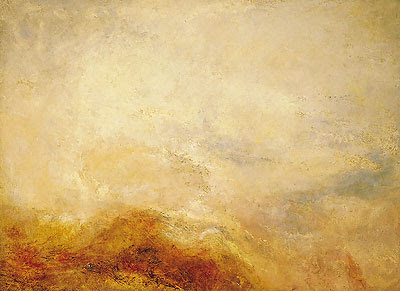From Bonny Dot Cassidy…

Joseph Mallord William Turner, A mountain scene, Val d’Aosta, c.1840.
Oil on canvas, 91.5x122cm
For about six months, I’d had a postcard of Turner’s A mountain scene, Val d’Aosta’ (c.1845) reproduction framed above my desk. It hung beside Antonella da Messina’s St Jerome in his labyrinthine study. The saint’s chemise, slung on a hook, is like a little fold of cloud itself; the bellies of the peacock and the partridge catches noon’s light, and I imagined that even the rough mane of Jerome’s pet lion had the same blushy glow as Turner’s scene.
Now, I realised that Turner had been hanging there upside down, as if it didn’t matter to the lofty anarchy of his cloudscape; but it does. The veil sweeps upward from the more solid foreground along the bottom of the picture. Its direction is as important as whether a gust goes east or west. For Turner, black comes from down below—a telluric bile that can rise through water and seep up through earth. In his mountain scene, it colours the earth in flickers but it doesn’t reach the sky. Where is it taken? Sometimes, in his views of ocean, light is submerged by the blackness; here, however, it triumphs with a levitating effect that draws us further and further from those gritty, earthly flecks.
Antonello da Messina, St Jerome in his Study, circa 1475.
Oil on lime wood. The National Gallery, London.
Now, as I stand before it (resisting the swell of the crowd at the National Gallery, a rising warmth that only draws me closer to the painting’s altitude), the work reaches out rather than retracting into a cool, resplendent drift. Impasto is lodged into the surface of the underpainting: little happenings of pure zinc whiteness that, at first, seem to be bristle or cord stuck over the painting’s surface. In fact, their growth from within the very matter of the work forces its motion not only upward but also outward—an expanding, humid scene that is all about dispersion and displacement. I can practically feel the atoms of mountain haze bouncing off my nose and cheeks. Frontally, the work is dry and scumbled but taken from an angle it is slick with wet sheen. The smoothed expanses come into their own, spread flat as the cloud thins to reveal blue.
And it is paler, on the whole, than I had thought. The work’s golden yellow is important, discolouring the upper reaches of cloud to the shade of dirty snow. It’s reflected from the earth, and becomes the distant mauve of the farther peaks. But it plays second, both compositionally and tonally, to the wrapping of white that advances first north, then west, and finally into Chaos.
